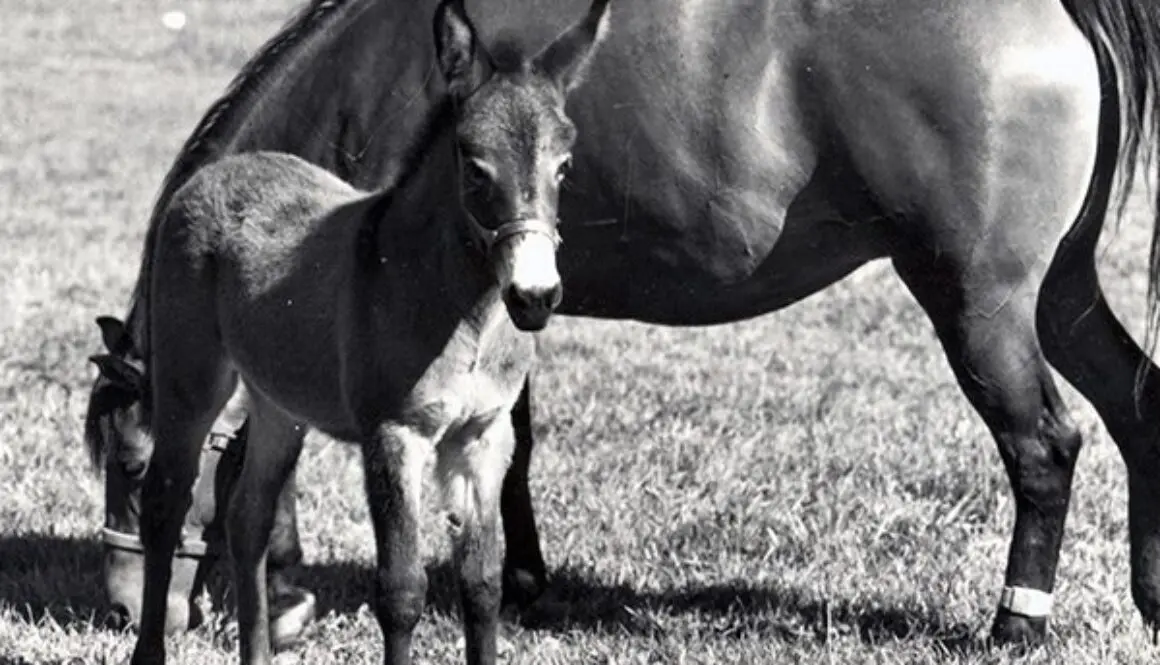
Meredith Hodges

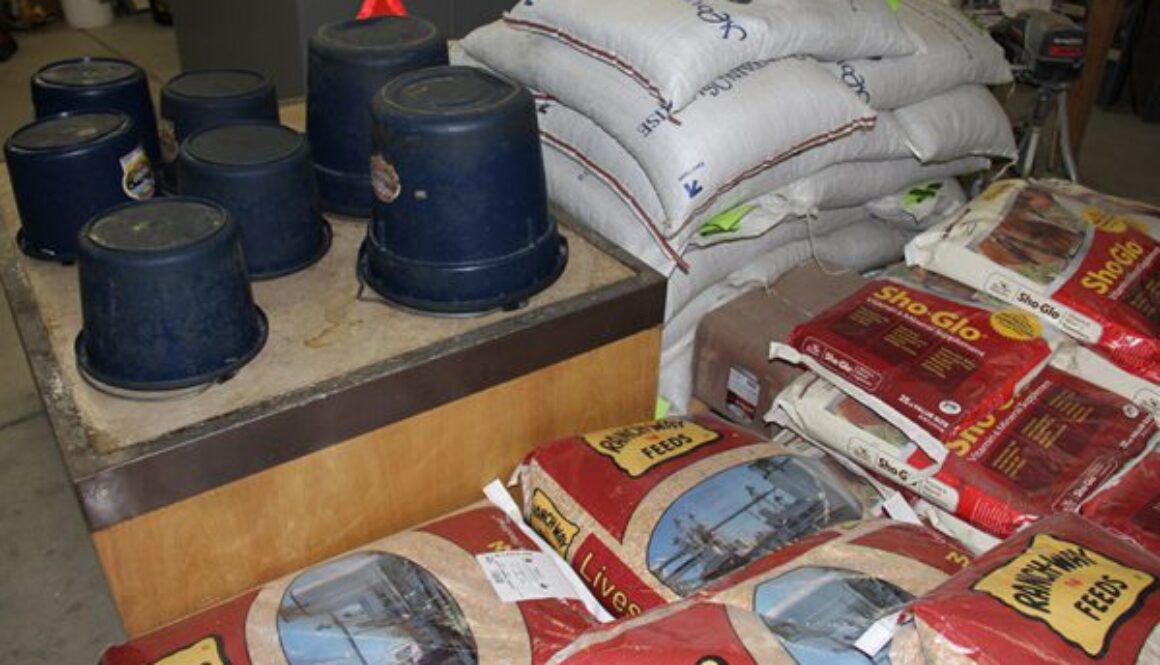
LTR Training Tip #6: Feeding Time – Oat Mixture
Meredith gets a lot of letters and emails from people with training questions about their equines. Here, she discusses the best way to incorporate an oats mixture into your equine’s diet.

MULE TALK! PODCAST: Donkey Training, Part 3
-
When your donkey is doing well with the trot, time to learn to canter.
-
Use verbal commands with your donkey.
-
Training your donkey to move laterally.
-
Using the hourglass pattern in your training to improve posture and overall balance.
-
Using your elbow pull as a training aid.
-
Training your donkey at Cavalletti.
-
Training your donkey for jumping. And more!
Learn more on Mule Talk podcast.

MULE TALK! PODCAST: Donkey Training, Part 2
- Repeat the previous lesson – BUT DO NOT DRILL YOUR DONKEY.
- Training your donkey to trot with a rider.
- Execute pattern training with your donkey to strengthen his body.
- Your assistant will only help you when needed while training your donkey.
- Training turns on the forehand with your donkey.
- Going straight on the rail.
- Be patient and understanding – your donkey will give what he is able to do.
- Training turn on the haunches with your donkey – and more!
Learn more on Mule Talk podcast.

MULE TALK! PODCAST: Donkey Training, Part 1
Donkey Training, Part 1 –
-
Begin with imprinting the foal.
-
Introducing the halter to your young donkey.
-
Leading your donkey.
-
Never be in a hurry when training your donkey.
-
Lead your donkey around your workstation.
-
Begin training in round pen.
-
Using the lunge line in your training session.
-
Do not drill your donkey OR mule.
-
Line driving your donkey and more!
Learn more on Mule Talk podcast.

MULE TALK! PODCAST: Multiple Facets of Longears Hybrid Vigor
- What are mules and hinnies?
- What are the physical characteristics of the Ass?
- What are the mental characteristics of the Ass?
- What kind of hybrid equines are there?
- Listen to the many Horse, Mule, and Donkey Hybrids.
- Mules are good mothers too!
- Amazing documented findings of mules giving birth!
- What to look for in a gaited jack.
Learn more on Mule Talk podcast.
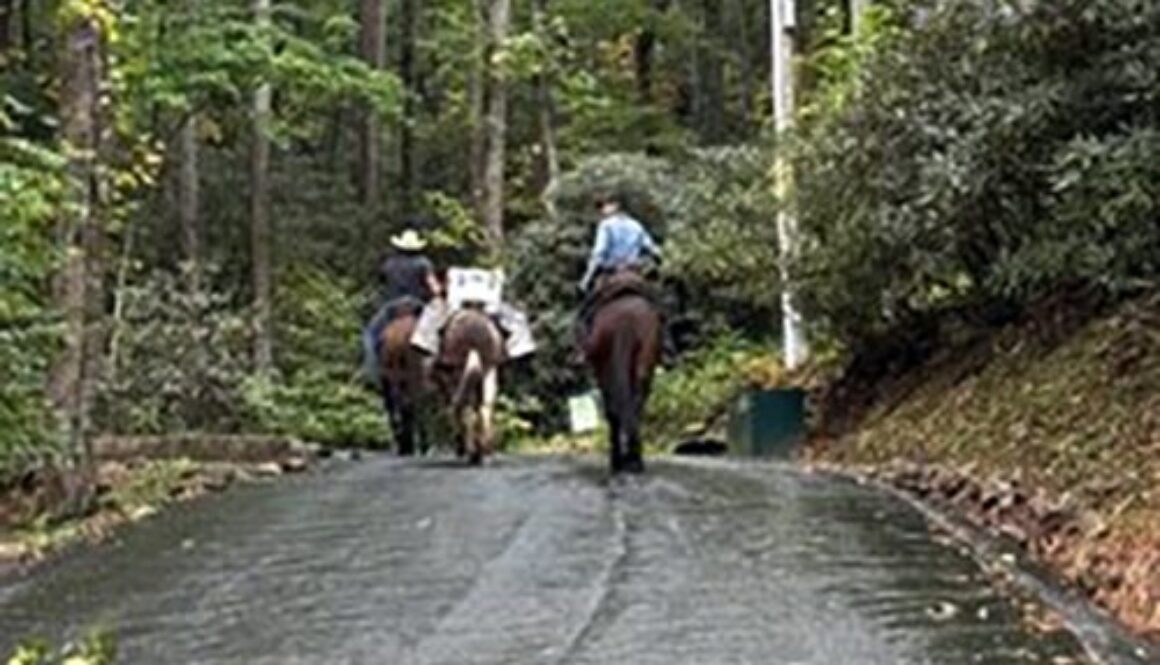
MULE CROSSING: What are Mules Good for Besides Packing and Farming?
By Meredith Hodges
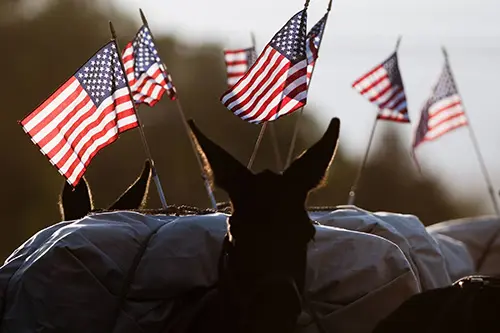 The modern contemporary mule of the late 1970s has emerged as a fine saddle, driving and pack animal. No longer does he come from exclusively low grade mares. With the upgrading of mule breeding, the mule is a new, gentle and versatile animal capable of performing well in all forms of equine athletics. He can do cow work, work and pleasure driving, packing, jumping and is better suited for long trails, yet he still possesses all the traits that have made mules popular throughout the centuries: a willingness to work, an easy keeper, more resistance to parasites and disease, extremely surefooted and his indubitable intelligence that is often confused with stubbornness.
The modern contemporary mule of the late 1970s has emerged as a fine saddle, driving and pack animal. No longer does he come from exclusively low grade mares. With the upgrading of mule breeding, the mule is a new, gentle and versatile animal capable of performing well in all forms of equine athletics. He can do cow work, work and pleasure driving, packing, jumping and is better suited for long trails, yet he still possesses all the traits that have made mules popular throughout the centuries: a willingness to work, an easy keeper, more resistance to parasites and disease, extremely surefooted and his indubitable intelligence that is often confused with stubbornness.
Mules are capable of being used for as many different things as are all breeds of horses put together. Since a mule gets most of his ability from the mare, one need only scout a mule out of a 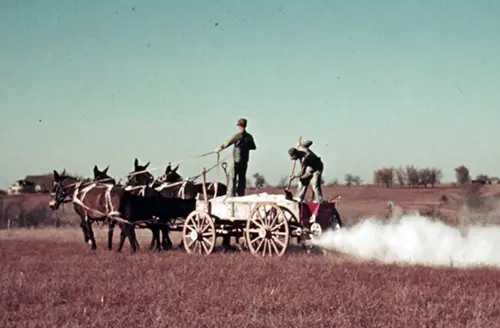 particular kind of horse to match the desired ability. A mule out of any breed of horse will be stronger and more durable than the horse out of which he came.
particular kind of horse to match the desired ability. A mule out of any breed of horse will be stronger and more durable than the horse out of which he came.
Mules played an important role in our country during the Reconstruction Period: they patiently worked the fields, packed necessary artillery for the army, and served as a durable riding and driving animal in the westward movement.
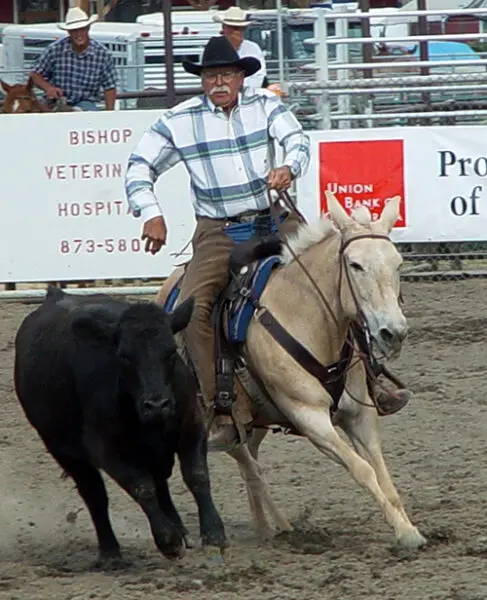 With the coming of the industrial age, their uses were minimized and they were faced with the possibility of extinction in the march of progress. Today, through the persistent determination of mule enthusiasts, mules are once again emerging as a conceivable asset to our economy and a unique form of athletic achievement and entertainment.
With the coming of the industrial age, their uses were minimized and they were faced with the possibility of extinction in the march of progress. Today, through the persistent determination of mule enthusiasts, mules are once again emerging as a conceivable asset to our economy and a unique form of athletic achievement and entertainment.
With new and improved training techniques, the mules of today are known for their beauty and outstanding athletic ability, their durability and their intelligence. Their uses are limited only to the imaginations of their owners. It is now commonly known that with proper training, a mule can perform better than the horse it was bred from. Subsequently, mules are not only competing in mule shows, but horse shows as well—in events from cutting to dressage. Cattle ranchers have discovered the mule to be an important asset in their business. He can go all day without tiring and can cover terrain that might discourage a horse, not to mention that the ride is much more comfortable.
Hunters caught in the heavy snows of the Rocky Mountains praise their mules for carrying out heavy game and blazing trails through treacherous snowy ground, leading them and their horses to safety. Sales persons are grateful to both mules and donkeys for their humorous contributions in advertising and children appreciate the companionship and affection that mules can offer.
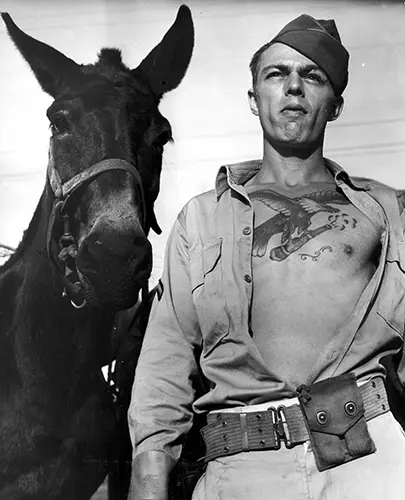 Even the army has conceded that mules could make their contribution to the economy through their use in mountain light infantry divisions. The only problem that arises is educating people on mule psychology so that they can train them properly.
Even the army has conceded that mules could make their contribution to the economy through their use in mountain light infantry divisions. The only problem that arises is educating people on mule psychology so that they can train them properly.
Though we are still a busy society, with the help of technology we are more able to give the mule the time and appreciation he deserves. Consequently, we are continually discovering new uses for the much-maligned mule, enjoying him more, and in the process, we’re putting the old wives’ tales to rest.
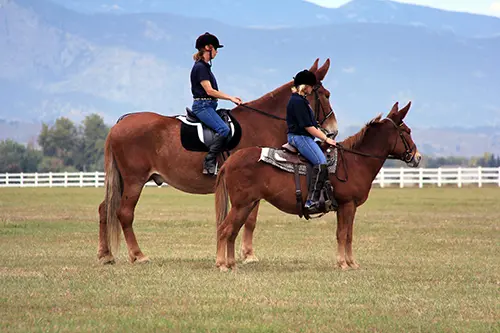 Yesterday’s mules sturdy and strong
Yesterday’s mules sturdy and strong
The days in the fields were often quite long
The man with the whip sometimes evened the score
With a jolt to the head by a stout two-by-four.
“Understanding” a word not common for slaves
Caused many good mules to go to their graves
“Stubborn and cranky are mules,” said most men
Who used and abused them then were kicked or bitten.
When industry triumphed, the mules quickly faded
But the tales remained and were often quite jaded
Twas never the man with the stout two-by-four
Who was wrong from the start to push mules way too far
But the folks who were ignorant knew only what’s said
And since mules cannot talk, their reputation was dead
They’re known to be pushy, vengeful, and cross
So man abandoned the mule for his exquisite horse.
But even after the industrial revolution, mules exhibited their versatility and once again defined their use for the new age. The military dispersed their cavalries and sold most of their mules in lieu of motorized all-terrain vehicles. However, when they got up into the Rocky Mountains, they still found some areas impenetrable and had to resort to the use of pack mules yet again. In California, there is still a Military Mountain Mule Training Camp. And just recently…
INTERNET
Mules are being used to carry supplies into Western North Carolina
The animals are being used to carry water, diapers and other much-needed essentials into communities isolated after Helene.
Author: James Brierton (WCNC)
Published: 3:29 PM EDT October 1, 2024
Updated: 3:29 PM EDT October 1, 2024
Facebook
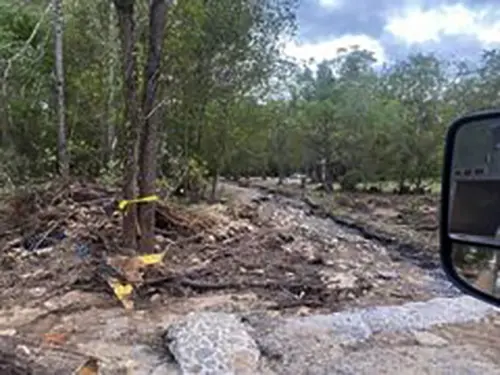 WEAVERVILLE, N.C. — After Helene isolated western North Carolina communities with landslides, flash flooding and road damage good Samaritans have had to find creative ways to bring in much-needed supplies.
WEAVERVILLE, N.C. — After Helene isolated western North Carolina communities with landslides, flash flooding and road damage good Samaritans have had to find creative ways to bring in much-needed supplies.
In addition to aircraft drops by military and civilian pilots, mule packers are using the animals to walk supplies into mountainous communities.
“Mules and equipment are loaded, and the first big batch of supplies has been purchased and loaded,” the Mountain Mule Packer Ranch posted on Facebook Monday. “We have two fully loaded trucks and 20′ stock trailers heading to WNC for assistance!”
Later Monday, the ranchers posted pictures of the animals and supply cargo to social media.
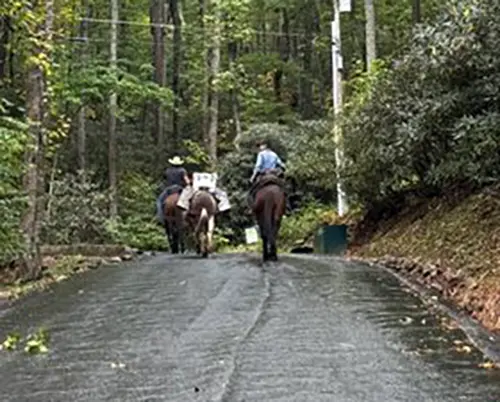 “We will be setting up a staging area and beginning to assist this afternoon,” they wrote on Monday, “and will be bringing up additional loads of supplies once mules are in place!”
“We will be setting up a staging area and beginning to assist this afternoon,” they wrote on Monday, “and will be bringing up additional loads of supplies once mules are in place!”
 Mountain Mule Packer Ranch is based out of Mount Ulla, which is located between Lake Norman and Salisbury in North Carolina. They have been using their Facebook page to announce when they will be at the Food Lion, located at 11745 Statesville Blvd. in Cleveland, NC, to collect donations.
Mountain Mule Packer Ranch is based out of Mount Ulla, which is located between Lake Norman and Salisbury in North Carolina. They have been using their Facebook page to announce when they will be at the Food Lion, located at 11745 Statesville Blvd. in Cleveland, NC, to collect donations.
Busy morning as we loaded lots of equipment, supplies, and MULES, to leave for WNC! Please know that we appreciate EVERY kind word, gesture of support, and all that are partnering with us to HELP all that we can! We will be setting up a staging area and beginning to assist this afternoon and will be bringing up additional loads of supplies once mules are in place! #prayingforthoseaffectedbyhelene #mulepower #StrongerTogether #mountainmulepackers #militarymules
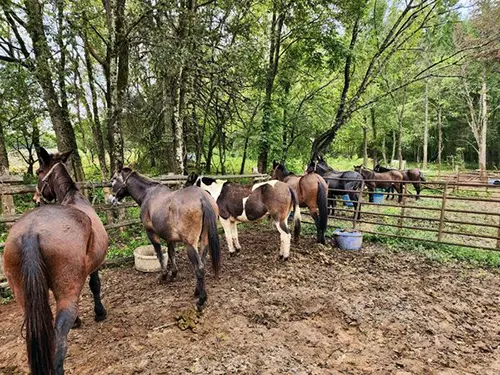 The Mountain Mule Packer Ranch partnered with the Cajun Navy, another group of civilian volunteers, to deliver insulin to a family on Monday, according to their Facebook posts.
The Mountain Mule Packer Ranch partnered with the Cajun Navy, another group of civilian volunteers, to deliver insulin to a family on Monday, according to their Facebook posts.
The ranchers have setup their staging area in Montreat on Tuesday. They were planning to make trips into Black Mountain.
Mountain Mule Packer Ranch
October 1, 6:31 a.m.
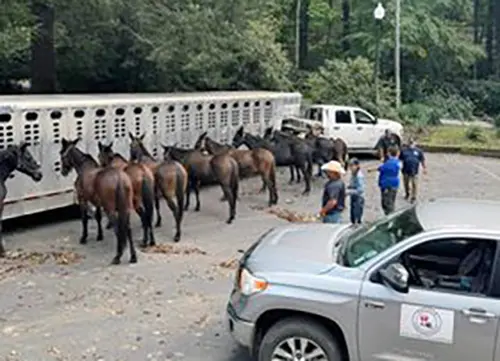 8:30am update 10/1/24 Mike and the mule team made it to their staging area in Montreat yesterday and have already been helpful to families in need! They will be doing all they can in Black Mountain today. Thankful to Five 11’s Livestock Hauling for offering help in hauling mules so we could bring more supplies up! And appreciate being able to help support Cajun Navy 2016 on their efforts as well!
8:30am update 10/1/24 Mike and the mule team made it to their staging area in Montreat yesterday and have already been helpful to families in need! They will be doing all they can in Black Mountain today. Thankful to Five 11’s Livestock Hauling for offering help in hauling mules so we could bring more supplies up! And appreciate being able to help support Cajun Navy 2016 on their efforts as well!
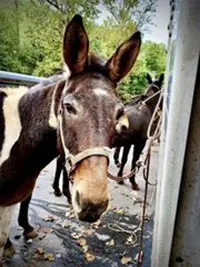 The team here at the ranch will be shopping for more supplies today, to restock them tomorrow! We appreciate the huge outpouring of requests on how to get supplies to us. Because of the conditions in the mountains and the way the team will be moving around, that is hard to coordinate. I will bring a trailer to the Food Lion Shopping Center this afternoon at approximately 4pm if there is anyone in the area that wants to add to the supplies we are bringing! Please let me know if this is something you’d like to do, and we can be there between 4-5pm today to collect what you have!! God bless you all, and thank you for keeping prayers lifted up!!
The team here at the ranch will be shopping for more supplies today, to restock them tomorrow! We appreciate the huge outpouring of requests on how to get supplies to us. Because of the conditions in the mountains and the way the team will be moving around, that is hard to coordinate. I will bring a trailer to the Food Lion Shopping Center this afternoon at approximately 4pm if there is anyone in the area that wants to add to the supplies we are bringing! Please let me know if this is something you’d like to do, and we can be there between 4-5pm today to collect what you have!! God bless you all, and thank you for keeping prayers lifted up!!
Food Lion 11745 Statesville Blvd., Cleveland, NC
EQUUS MAGAZINE
Horse, mule groups aid NC storm victims
Much-needed supplies are being packed and airlifted into affected areas
October 3, 2024
⎯ Edited Press Release
NOTE: This is a developing story that will be updated periodically.
A force of nature called Helene made landfall as a deadly category 4 hurricane late on the evening of September 26, 2024, along the Florida Gulf Coast. One day later, as Helene weakened to a tropical storm, it unleashed damaging winds, unprecedented rainfall and torrential flooding across the southeast U.S., with Georgia and the Carolinas particularly hard hit. Donated hay/Sandhills Pony Club social media.
In some cases, entire inland communities have been wiped out in scenes described as “apocalyptic.” The degree of destruction is staggering, and the death toll continues to rise, with rescue operations in full swing and hundreds of people still believed missing at this writing. In the wake of the devastation, groups such as the Mountain Mule Packer Ranch in Mount Ulla, North Carolina, and the Sandhills Pony Club of Pinebluff, North Carolina, have mobilized to help victims of Helene in that state’s western mountains, many of whom have been stranded for days without food, water, cell power, electricity and passable roads.
Their targets include not only the people in these locations, but their animals, as well.
Packing it in
In the case of the Mountain Mule Packer Ranch, a business that offers training in tactical mule packing, the objective is getting much-needed supplies in by pack mule strings to especially hard-to-reach mountain locations. The mules and supplies are being hauled to local staging areas from which they are being deployed. According to reports, each of the mules can carry 200 pounds of supplies, everything from food and water to diapers and medical needs like insulin.
In a recent Facebook post, the Mountain Mule Packer Ranch asked that anyone who wants to donate to their mission or who knows of “specific needs and areas” where mule-string help might be warranted please reach out to them at (910) 885-1402. “We can bring supplies or pack in what your group has acquired already,” the post reads. There have also been reports of vital supplies being carried into the mountains by individuals on horseback.
Airlifting hay and animal feed
Meanwhile, members of the Sandhills Pony Club are using airlifts and ATVs to transport donated hay, feed and animal supplies into zones where horses, other livestock and pets have not been evacuated.
Recently added to the pony club’s wish list: Pet food in easily transportable sizes, roll-type temporary fencing, five-gallon jugs for water and small bags of high-performance dog food like Purina Pro-Plan and Diamond Performance (no chicken, please) for the hardworking Search and Rescue dogs.
The group is also asking for additional volunteers to help coordinate this massive relief effort. Call (615) 268-9145 or email sandhillsponyclub@gmail.com for more information.
A post on the club’s Facebook page directs those wishing to help to send donations by Venmo (@Sandhills_PonyClub) or mail a check to Sandhills Pony Club, 255 Cliffman Rd., Pinebluff, NC 28373.
Landing page image from Mountain Mule Packer Ranch social media
“With more time to our leisure the mules of today
Are treated much better and perform just that way
The love and affection the mules can now give
Makes raising and training a warm way to live.
To meet them and greet them, to own one or not
The mules of today exhibit just what they got!
We’ve banned the “Old Wives’ Tales” and made a new rule
If you aren’t too stubborn, why not ride a mule!”
Again with the devastation in North Carolina, South Caroline, Georgia, Florida, Alabama and Tennessee, mules are once again traveling far into areas that prohibit motorized vehicles from going. There are particularly remote areas in the Appalachian Mountains that can be truly difficult to navigate due to extremely steep trail and low hollers along the riverbanks as described in a book I read about the first women on mules that delivered books to these remote areas. Private citizens with their mules and horses were timely in their response and are definitely continuing to make a difference in the lives of the people who have been left homeless and floundering after this horrible disaster. Mules will always be an asset to our American way of life due to their outstanding characteristics, versatility and ability to go where not all men can go!
To learn more about Meredith Hodges and her comprehensive all-breed equine training program, visit LuckyThreeRanch.com, MEREDITH HODGES PUBLIC FIGURE Facebook page, or call 1-800-816-7566. Check out her children’s website at JasperTheMule.com. Also, find Meredith on Pinterest, Instagram, MeWe, YouTube and Twitter.
Covered in TRAINING MULES & DONKEY: A LOGICAL APPROACH TO TRAINING, TRAINING WITHOUT RESISTANCE and EQUUS REVISITED at www.luckythreeranchstore.com.
© 1985, 2016, 2024 Lucky Three Ranch, Inc. All Rights Reserved.

MULE TALK! PODCAST: Keys to Successful Training Part 2
- Establishing a bond.
- Feeding.
- Consideration
- Structured exercises.
- Body language and verbal communication.
- Benefits of group lessons.
- Take lessons periodically to stay on track to improve your own skills.
- Lists of trainers and instructors can be obtained from the United States Equestrian Federation and the American Donkey & Mule Society.
Learn more on Mule Talk podcast.

MULE CROSSING: Rewards, Treats, Coaxing and Bribing
By Meredith Hodges
 It is important to know the differences among rewards, treats, coaxing and bribing in order to correctly employ the reward system of training called Behavior Modification.
It is important to know the differences among rewards, treats, coaxing and bribing in order to correctly employ the reward system of training called Behavior Modification.
Rule Number One: Treats and bribery should never be used during training. However, the appropriate dispensing of rewards and coaxing will produce the correct behaviors.
In order to reward your equine correctly for performing tasks, it is important to know the difference between a reward and a treat, and between coaxing and bribing. Let’s begin with some basic definitions of these terms:
Reward: something desirable given for a completed task
Treat: an unexpected gift given simply because it will be enjoyed
Coax: to gently persuade without dispensing the reward
Bribe: to persuade the animal by indiscriminately dispensing treats
 Remember to give your equine a reward only after a specific task you’ve asked for has been performed—or even an assimilation of that task, which means the taking of baby steps toward completing the task. The reward should be given immediately upon completion of the task and then your equine should be allowed time to enjoy his reward before moving on to the next task. If your equine is given a food reward for only good behaviors, he will be more likely to continue to repeat only those behaviors for which he is rewarded and you can begin to “shape” his behavior in a positive way.
Remember to give your equine a reward only after a specific task you’ve asked for has been performed—or even an assimilation of that task, which means the taking of baby steps toward completing the task. The reward should be given immediately upon completion of the task and then your equine should be allowed time to enjoy his reward before moving on to the next task. If your equine is given a food reward for only good behaviors, he will be more likely to continue to repeat only those behaviors for which he is rewarded and you can begin to “shape” his behavior in a positive way.
Treats, on the other hand, are a food that your equine especially likes, which are given randomly and without purpose. Giving random treats during training can result in crossed signals and confusion in your animal. Treats such as peppermints and even “horse treats” are generally an inappropriate food source for equines and when dispensed too freely, have actually been known to cause equine health problems, so forego treats of any kind during the training process.
Coaxing and bribing can seem like the same thing, but they are not. Bribery suggests the actual dispensing of a reward before the task has been completed. Bribery is the indiscriminate dispensing of treats and is not the way to clearly communicate to your equine which is truly a positive behavior and which is not. Rewards and coaxing are often confused with bribery, but rewards are dispensed for a task only when it has been completed, and coaxing using the promise of a reward can often be used to help your equine to stop balking and attempt to perform the task you have requested. Then the reward is given only when he has completed the task.
 As an example of coaxing, you can extend a handful of crimped oats to lure your equine closer to an obstacle, but he should not receive the handful of oats until he completes the required task or travels enough distance toward the obstacle to deserve a reward. If your equine just won’t come all the way to an obstacle, even to get a reward, you can modify the task by asking your equine to just come closer to the obstacle and then halt (but without backing up). Then the reward can be dispensed for the partial approach and halt, because these actions still qualify as an assimilation of the bigger task that is to be completed. If he backs away at all, he should not be rewarded and you will have to go back to the beginning of the task and try again.
As an example of coaxing, you can extend a handful of crimped oats to lure your equine closer to an obstacle, but he should not receive the handful of oats until he completes the required task or travels enough distance toward the obstacle to deserve a reward. If your equine just won’t come all the way to an obstacle, even to get a reward, you can modify the task by asking your equine to just come closer to the obstacle and then halt (but without backing up). Then the reward can be dispensed for the partial approach and halt, because these actions still qualify as an assimilation of the bigger task that is to be completed. If he backs away at all, he should not be rewarded and you will have to go back to the beginning of the task and try again.
A kind word or a pat on the head may be enjoyable for your equine, but it doesn’t necessarily insure that the desired behavior will be repeated. However, a food reward insures that desirable behaviors will be repeated, because food is a solid, tangible reward. The food reward will back up the petting, (the petting is something that you probably do all the time anyway). When you visit your equine, you most likely pat him on the nose or head and say hello, but there are no real demands for any particular task being asked of your equine—you and your equine are simply interacting. You’re getting him used to touch, discovering how he likes to be touched and learning about his responses, which is actually part of imprinting.
The problem with carrots, apples and other foods people use for treats is that they’re not something for which the equine will continue to work and are not healthy choices for your animal in large quantities. After a limited amount of time, equines can easily become satiated on most treats. It’s like a kid with a bunch of candy bars. Once they become full they don’t want any more candy and they’ll stop working for the treat. Many foods used as treats, when given too freely, may also cause your animal to become tense or hyperactive. However, it’s been my experience that an equine will continue to work for crimped oats as long as you dole them out. Crimped oats are healthy for the body and they don’t cause an equine to become tense and difficult to handle.
When you’re using rewards, always start with lavish rewards for all new behaviors. This means that, every time you teach something new, you’re going to give lavish rewards for even the slightest assimilation toward the correct behavior. For instance, if your foal is tied to the fence and upon your approach, he quits pulling, it’s time to try to walk away from the fence with him and see if he will follow you. In this first leading lesson, you’ll untie him and ask him to take a step toward you. If he does, lavishly reward that step toward you, wait for him to finish chewing his oats and then ask him to take another step forward and toward you. If he complies and takes another step forward, lavishly reward that step too. During the first lesson, you will be rewarding every single step he takes toward you. Remember to keep the lesson short (about 15 minutes) and ask for only as many steps as he willingly gives you.
 Between lessons, let your equine have a day off in order to rest. When you return for the second lesson, tie him to the fence and review with him your last lesson from the very beginning. He should remember the previous lessons and be willing to follow you right away in order to be rewarded. If he seems willing to follow your lead, untie him and ask him to take a step forward just as he did before, but this time, instead of dispensing the food reward when he takes the first step forward, simply say, “Good boy” and ask him for a second step forward before you reward him with the oats. You will now be progressing from one step forward before you reward to two steps forward before you reward.
Between lessons, let your equine have a day off in order to rest. When you return for the second lesson, tie him to the fence and review with him your last lesson from the very beginning. He should remember the previous lessons and be willing to follow you right away in order to be rewarded. If he seems willing to follow your lead, untie him and ask him to take a step forward just as he did before, but this time, instead of dispensing the food reward when he takes the first step forward, simply say, “Good boy” and ask him for a second step forward before you reward him with the oats. You will now be progressing from one step forward before you reward to two steps forward before you reward.
If he won’t take the second step forward, then give the reward for the first step, wait for him to finish chewing and ask again for two steps before rewarding him again. If he complies, you can then reward him every two steps during that lesson and quit after fifteen minutes. Give him another day between lessons and then proceed in the same manner, beginning with a review of the previous lesson, then a reward for the first step, and then for every two steps. During this lesson, you can now ask for three steps, and you can continue asking for three or more steps during this lesson, provided that he takes these steps willingly and then stops obediently on his own to receive his reward. You no longer need to count the steps as long as he is offering more steps between rewards each time. If, because of his enthusiasm, he begins to charge ahead, stop him and immediately reward him for halting. This will insure that he keeps his attention on you and the task at hand. This methodical, deliberate process is setting the stage for a positive and healthy working relationship with your equine.
 This is how you begin with leading training, and also how you should proceed with all the new things that you will be teaching your equine. In the beginning of leading training, he gets rewarded for even an assimilation of what you’re asking. For example, when you get to negotiating obstacles, your goal may be to cross over a bridge, but when your equine sees the bridge ahead, he may stop or start backing up. At this point, allow him to back until he stops. Go back and repeat the steps you did prior to approaching the obstacle. Then, asking for only one step at a time, proceed as you did during his flatwork leading training toward the bridge, rewarding each step he takes. Tell him verbally how brave he is and continue to reward any steps he takes toward the obstacle before proceeding forward. Remember to stop at any interval where he becomes tense, ask for one more step to be rewarded, and then allow him to settle and refocus before asking any more from him.
This is how you begin with leading training, and also how you should proceed with all the new things that you will be teaching your equine. In the beginning of leading training, he gets rewarded for even an assimilation of what you’re asking. For example, when you get to negotiating obstacles, your goal may be to cross over a bridge, but when your equine sees the bridge ahead, he may stop or start backing up. At this point, allow him to back until he stops. Go back and repeat the steps you did prior to approaching the obstacle. Then, asking for only one step at a time, proceed as you did during his flatwork leading training toward the bridge, rewarding each step he takes. Tell him verbally how brave he is and continue to reward any steps he takes toward the obstacle before proceeding forward. Remember to stop at any interval where he becomes tense, ask for one more step to be rewarded, and then allow him to settle and refocus before asking any more from him.
Once he goes to the bridge without a problem, you no longer have to reward him all the way up to the bridge. Just reward him when he actually gets to the bridge. Next, step up onto the bridge and ask him to take a step up onto the bridge with his two front feet, which is another new task. If he puts one foot on the bridge or even tries to lift up a foot and put it on the bridge, make sure you reward that behavior. Once he has a foot firmly placed on the bridge, keep tension on the lead rope and ask for his other front foot to come up onto the bridge. If he places his second foot on the bridge, you can then reward him for having both front feet on the bridge. Next, you’re going to continue forward and just walk over the bridge to the other side, pause and reward. Then quit this lesson. In his next lesson, if needed, repeat the approach the same way if he starts to balk. If not, ask him to step both front feet up onto the bridge, stop, make sure he is standing squarely, and reward that behavior.
 Now you no longer need to reward for one foot on the bridge. This is called “fading or phasing out” the reward for a previous behavior (one step), while introducing the new behavior of walking to the bridge, halting and then putting two front feet up on the bridge. Wait for a moment for him to chew his reward and then ask him to continue onto the bridge, stop and square up with four feet on the bridge and reward. If he does not comply and won’t stop on the bridge, just go back to the beginning, approach the bridge as described and try again until he stops to be rewarded with all four feet placed squarely on the bridge
Now you no longer need to reward for one foot on the bridge. This is called “fading or phasing out” the reward for a previous behavior (one step), while introducing the new behavior of walking to the bridge, halting and then putting two front feet up on the bridge. Wait for a moment for him to chew his reward and then ask him to continue onto the bridge, stop and square up with four feet on the bridge and reward. If he does not comply and won’t stop on the bridge, just go back to the beginning, approach the bridge as described and try again until he stops to be rewarded with all four feet placed squarely on the bridge
Then you ask him, to place his two front feet on the ground while leaving his two back feet on the bridge. Then have him stop and square up to be rewarded. This is a difficult position and if he cannot succeed by the third attempt, you may have to step in front and aid in his balance, then reward him when he settles in this position.
 The last step over the bridge is to bring the hind feet off the bridge, stop and square up one more time before he gets rewarded. This does two things. It causes your equine to be attentive to the number of steps you are asking and it puts him in good posture at each stage so that his body will develop properly. In future lessons, the steps in the approach to the bridge no longer need to be rewarded and as he becomes more attentive, he will learn to stop any time you ask and wait for your cue to proceed. After several months of this meticulous attention to these detailed steps, he will not necessarily need to be rewarded with the food reward each time—a pat on the neck and kind words of support should be sufficient. Rewards can then be given for whole “blocks” of steps when he successfully completes them.
The last step over the bridge is to bring the hind feet off the bridge, stop and square up one more time before he gets rewarded. This does two things. It causes your equine to be attentive to the number of steps you are asking and it puts him in good posture at each stage so that his body will develop properly. In future lessons, the steps in the approach to the bridge no longer need to be rewarded and as he becomes more attentive, he will learn to stop any time you ask and wait for your cue to proceed. After several months of this meticulous attention to these detailed steps, he will not necessarily need to be rewarded with the food reward each time—a pat on the neck and kind words of support should be sufficient. Rewards can then be given for whole “blocks” of steps when he successfully completes them.
Here is a question a lot of people ask: “This is fine while my animal and I are still working from the ground, but what happens when I finally get on to ride? Do I keep rewarding every new behavior when I ride?” The answer to that question is, “No, you don’t.” If you do your ground work correctly, it will address all the things that you’ll be doing while you’re riding before you actually even get on. Your equine has been lavishly rewarded for stopping when you pull on the reins and the drive lines, and he’s been rewarded for turning and backing and everything else he needs to learn before you actually get on him, so the only thing left to get used to would be exposure to your legs on his sides. He will soon learn that your legs push him in the direction of the turn you are indicating with your reins. For this action, he does not need to be rewarded.
 In the natural progression of correct training—including during mounting training—your equine should also be getting rewarded when you’re first getting him used to your being on-board. Give him the oats reward for standing still while you attempt to mount (i.e., walking toward him, holding the left rein and reaching for the saddle horn), and then when you hang from each side of his body with a foot in the stirrup (first on one side and then on the other side), and, finally, from each side of his body while you sit on his back. When you ask him to turn his head to take the oats from your hand, you can be sure his attention will be on you because this action will force him to look at you in order to receive his oats. Then reward him again for standing still as you dismount. Consequently, by the time you actually get to the point of riding in an open arena, he’s been rewarded for having you on his back and for behaving well through all the exercises demanded from him during round pen training.
In the natural progression of correct training—including during mounting training—your equine should also be getting rewarded when you’re first getting him used to your being on-board. Give him the oats reward for standing still while you attempt to mount (i.e., walking toward him, holding the left rein and reaching for the saddle horn), and then when you hang from each side of his body with a foot in the stirrup (first on one side and then on the other side), and, finally, from each side of his body while you sit on his back. When you ask him to turn his head to take the oats from your hand, you can be sure his attention will be on you because this action will force him to look at you in order to receive his oats. Then reward him again for standing still as you dismount. Consequently, by the time you actually get to the point of riding in an open arena, he’s been rewarded for having you on his back and for behaving well through all the exercises demanded from him during round pen training.
You may first want to lunge your equine when you move into the open arena. Lunge him on the lunge line and reward him during that part of your arena workout. When you are ready to mount in the open arena, have a few oats in your pockets to offer him when you mount on each side the first few times. This will ensure that his attention stays focused on you. Once he is used to being ridden, you will no longer have to reward him in the middle of riding lessons. If he does not keep his attention on his work in the open arena, this signifies that not enough time has been spent on the ground work and you should back up your training regimen to the point that he is maintaining attentiveness and performing correctly, even if it means going back to the round pen or leading work. If, in the ground work stages, you give plenty of food rewards in the correct manner, by the time you groom and tack up, your equine should have been sufficiently rewarded and will not require another reward until after your workout when you return to the work station and un-tack him. This is called delayed gratification. When you un-tack him and do your last minute grooming before putting him away, again be generous with the crimped oats and praise your equine for a job well done. Rewards are dispensed very specifically and pave the road to a solid foundation of trust and friendship.
To learn more about Meredith Hodges and her comprehensive all-breed equine training program, visit LuckyThreeRanch.com, MEREDITH HODGES PUBLIC FIGURE Facebook page, or call 1-800-816-7566. Check out her children’s website at JasperTheMule.com. Also, find Meredith on Pinterest, Instagram, MeWe, YouTube and Twitter.
© 2013, 2016, 2018, 2021, 2022 Lucky Three Ranch, Inc. All Rights Reserved.
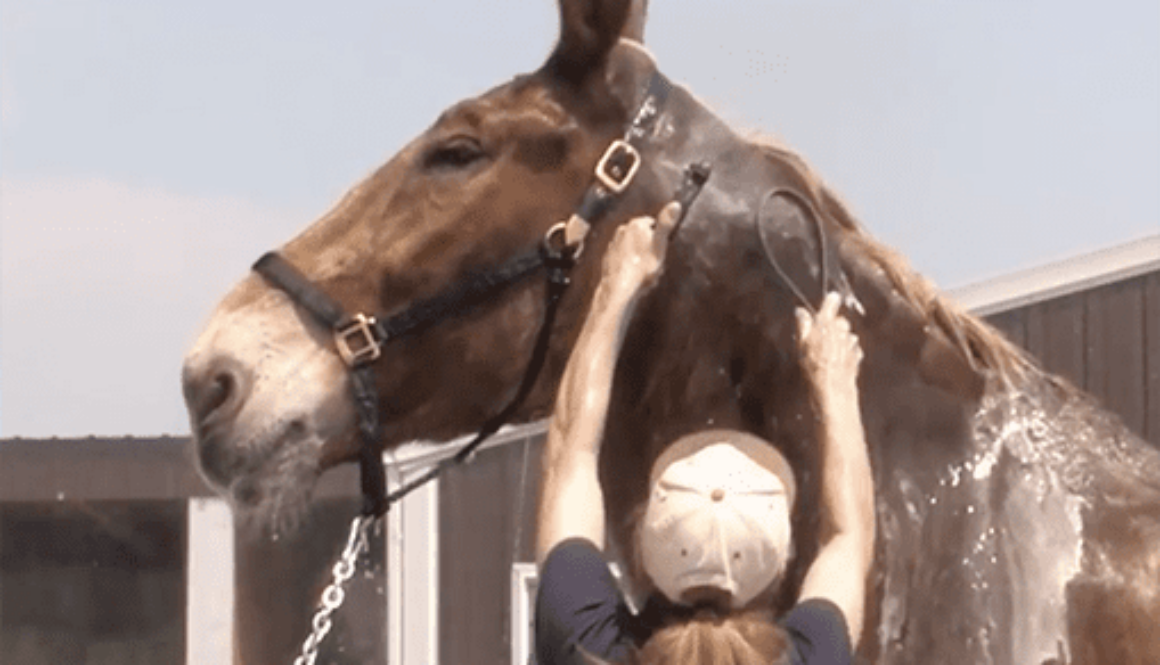
MULE CROSSING: Multiple Facets of Longears Hybrid Vigor
By Meredith Hodges
“Hybrid vigor is the increase in certain characteristics like growth rate, size, fertility, yield etc. of a particular hybrid organism over its parents. Hybrid vigor is also known by some other names, including heterosis and inbreeding enhancement. Hybrid vigor occurs because the hybrid offspring’s traits are enhanced due to the mixing of genetic contributions of its parents.”
What are mules and hinnies?
The mule is a hybrid cross between a male donkey (jack) and a female horse (mare). Because the mule most often demonstrates the best traits from each parent, he possesses what we call hybrid vigor. The mule inherits from the donkey his incredible strength, intelligence, patience, perseverance, endurance and surefootedness from the jack and his equine beauty, athletic ability and speed from the horse.

The hinny is also called a mule. However, the hinny is the hybrid cross between a male horse (stallion) and a female donkey (jenny, or jennet). Mules and hinnies are very difficult to tell apart without a DNA test. A hinny generally resembles a horse more than it does an ass. It looks more like a horse with long ears and looks very much like a mule. The hinny has been used as a saddle animal from antiquity and is more difficult to produce than the mule, because the jennet does not conceive well with the stallion.
 The hinny is a somewhat slower and more meticulous mover than the mule, but a laid back mule can offer similar characteristics. The hinny inherits his way of going from the jennet as does the mule, which tends to be a little faster, more energetic and more agile—like his dam, the mare. The hinny, because of his meticulous way of going, is actually better in very steep, rocky terrain and, especially, in loose rock, and will not tire as quickly as a mule. Hinnies are the preferred equine in Mexico and Central America due to their diligence when working. Gaited hinnies are preferable in this kind of terrain where there is little opportunity to gallop because they have a smooth, more ground-covering gait and offer a smooth ride.
The hinny is a somewhat slower and more meticulous mover than the mule, but a laid back mule can offer similar characteristics. The hinny inherits his way of going from the jennet as does the mule, which tends to be a little faster, more energetic and more agile—like his dam, the mare. The hinny, because of his meticulous way of going, is actually better in very steep, rocky terrain and, especially, in loose rock, and will not tire as quickly as a mule. Hinnies are the preferred equine in Mexico and Central America due to their diligence when working. Gaited hinnies are preferable in this kind of terrain where there is little opportunity to gallop because they have a smooth, more ground-covering gait and offer a smooth ride.
 The hooves of a hinny tend to be more donkey-like—narrow, oval and more upright—where the hooves of a mule will look more horse-like; a little rounder (although still oval), with slightly more angle than the donkey hoof, but not as flat, round and angled as the horse’s hoof. On both hinnies and mules, the hooves should be trimmed more upright and the heels should be left longer than the hooves of the horse.
The hooves of a hinny tend to be more donkey-like—narrow, oval and more upright—where the hooves of a mule will look more horse-like; a little rounder (although still oval), with slightly more angle than the donkey hoof, but not as flat, round and angled as the horse’s hoof. On both hinnies and mules, the hooves should be trimmed more upright and the heels should be left longer than the hooves of the horse.
The hinny will also eat a variety of different kinds of shrubs and bushes to sustain himself, where a mule will be more selective, again because of the influence of the mare. This makes the hinny more desirable to those people living in remote mountain areas with little vegetation.
Both the mule and the hinny have more endurance by far than the horse. They are more resistant to parasites and disease, require less feed for good health, have tougher hooves than the horse, and have an incredible sense of self preservation that keeps them safe, which is often mistaken for stubbornness. The horse has a flight reflex when startled and the donkey has a freeze reflex; mules and hinnies can exhibit both the freeze and flight reflexes, depending on their own unique personalities and the situation at hand.
Certain breeds of mares do not conceive as well with the jack as other breeds. When breeding for mules, since the jacks are generally smaller and of slighter build than a horse, mule foals are generally smaller than horse foals and the mare has very little problem foaling. When breeding for hinnies, one needs to be cautious, as the jennets are smaller and of a slighter build than mares. A large stallion could produce a foal that would be too large and difficult for the jennet to easily foal. This is the reason that breeding for mules is more popular than breeding for hinnies. Matching the size of the parents is much more important with hinnies. It is more difficult for a jennet to settle after being bred to a stallion than it is for a mare to settle after being bred by a jack, so breeding for hinnies can take significantly longer.
What are the physical characteristics of the Ass?

The ass has a distinctive bray, Long ears, a short upright and thin mane with hair only on the end of its tail. Mules tend to look more horse-like than donkeys. Asses and mules can come in a wide variety of colors. Their hooves are narrow and boxlike, unlike the oval shape of horse hooves. Their hooves are upstanding, and made for rock and mountain climbing. They are tough and elastic, non-chipping and can grow to long lengths when the animal is on soft ground and the hooves are left untrimmed. The ass has a long body with long, wiry muscles and a short, straight back. He lacks upstanding withers and is excellent for packing and weight bearing and his bone is dense and hard. Gestation is 12 months, whereas the gestation period for a horse is 11 months.
The ass usually has a white belly and muzzle, and circles around the eyes. His colors are much like that of a horse. They can  come in more colors than a horse, even an Appaloosa. Mule’s conformation falls somewhere in between that of the donkey and that of the horse. Mules inherit the best traits from both its sire and its dam. Mules get their athletic ability from the horse, while strength and intelligence come from the donkey. Mules today come in all shapes sizes and colors, from minis under 50 pounds to maxis over 1000 pounds, and in many different colors. Mules from Appaloosa mares produce wildly colored mules, much like their Appaloosa horse relatives, but with even wilder skewed colors. The Appaloosa color is produced by a complex of genes known as the Leopard Complex (Lp). Mares homozygous for the Lp gene bred to any color donkey will produce an Appaloosa colored mule.
come in more colors than a horse, even an Appaloosa. Mule’s conformation falls somewhere in between that of the donkey and that of the horse. Mules inherit the best traits from both its sire and its dam. Mules get their athletic ability from the horse, while strength and intelligence come from the donkey. Mules today come in all shapes sizes and colors, from minis under 50 pounds to maxis over 1000 pounds, and in many different colors. Mules from Appaloosa mares produce wildly colored mules, much like their Appaloosa horse relatives, but with even wilder skewed colors. The Appaloosa color is produced by a complex of genes known as the Leopard Complex (Lp). Mares homozygous for the Lp gene bred to any color donkey will produce an Appaloosa colored mule.
What are the mental characteristics of the Ass?
The ass is highly intelligent, alert, curious and affectionate, when not worn down by bad conditions (i.e., cruel treatment, bad shelter, bad food and water or overwork). They are quick to learn. A well-trained mule is calm, tolerant, loyal, affectionate, obliging and patient and sensitive. Mules and donkeys might be mistaken as being stubborn when they’re actually afraid or confused. The ass has common sense and is not prone to panic or carelessness. He can readily recognize danger!
What kinds of hybrid equines are there?
The following are simple definitions for the horses, mules and donkeys we will discuss:
Stallion: male horse
Mare: female horse
Jack or Jackass: male donkey
Jennet or Jenny: female donkey
Horse mule, john mule: male mule
Mare mule, molly mule: female mule
Horse, Mule and Donkey Hybrids:
Mule: donkey father + horse mother
Hinny: horse father + donkey mother
Donkule, Jule: donkey father + mule mother
Hule: horse father + mule mother
Zebroids (Zebra Hybrids)
Zedonk, Zebrass, Zebronkey, Zonkey, Zebonkey, Zebradonk, Zebryde: zebra father + donkey mother
 Zorse, Golden Zebra, Zebra mule, Zebrule: zebra father + horse mother
Zorse, Golden Zebra, Zebra mule, Zebrule: zebra father + horse mother
Zony: zebra father + pony mother
Zetland: zebra father + Shetland pony mother
Zebret, Donkra: donkey father + zebra mother
Hebra, Horbra, Zebrinny: horse father + zebra mother
Although hybrids are typically sterile, two documented cases of fertility do exist. One was known as Old Beck from Texas A&M, bred first by stallion, Pat Murphy, and yielded the hule, Pat Murphy, Jr. She was bred a second time to a jack and produced the jule, or donkule Kate. The other was Krause, belonging to Arthur Silvester in Champion, Nebraska. She was bred to a jack twice and foaled first with Blue Moon, and then with White Lightning. More numerous cases have emerged with the new technology and better national and international communication.
Happy Hinnies
This story comes from our friend, Luzma Maria Osorio, of Criadero Villa Luz in Colombia.

At our Stud Farm, Villa Luz, in Colombia, South America, we have been breeding mules and donkeys for more than fifteen years. There has been a big demand for our Paso Fino male donkeys (Jacks) to produce gaited mules through the years. But we were left with many female donkeys (Jennies), and nobody would buy them to produce mules even though they have the same good genetics and Paso Fino gait of their brothers. So we thought, let’s breed Hinnies–and the project began!
It is said that Hinnies often have shorter ears, although they are still longer than those of horses, and more horse-like manes and tails than mules. Well, our Hinnies certainly have the ear shape of their sire–they are beautifully pointed at the top just like his, but bigger. Up until now the behavior and characteristics of our Hinnies don’t differ much from the mules, they are lovely animals. It is our goal to study Hinnies and help to understand them better.

The good news is, the Paso Fino gait has passed to the Hinnies! This gait is natural and we have seen it in our baby Hinnies shortly after birth! Paso Fino is a lateral gait, four beat footfall, which provides a constant, rhythmic cadence. The rider should not experience any bumping or jolting. They say you can carry a tray with a glass of champagne on a Paso Fino equine as they are so smooth!!
We don’t know if they got the Paso Fino gait from the sire or the dam because both have it, but we certainly will have Paso Fino Hinnies! Very smooth, intelligent and well behaved!
Mules are good mothers too!
They say Mules cannot give birth and are hostile to foals, but the mule Chucurena has proved completely the opposite. On 25 September 2011 she gave birth to a beautiful baby mule in Colombia South America and she is proving to be a great mother! This miracle was achieved thanks to the Embryo transplant technique. A three day old embryo was extracted from a mare and implanted in the mule’s womb to develop it. Embryo transplants are a complicated process that requires synchronizing the ovulating time in both females, in this instance it was carried out by the specialized Colombian Veterinarian Hector Mendez.
 The embryo was from a Paso Fino Mare called La Querencia and the Paso Fino Donkey Cosaco XVI de Villa Luz. The pregnancy was 11 months and the delivery was normal with no complications, the mule knew exactly what to do and behaved as an expert mother even if it was her first time! The baby is a female and it was called “La bien querida” (The much loved).
The embryo was from a Paso Fino Mare called La Querencia and the Paso Fino Donkey Cosaco XVI de Villa Luz. The pregnancy was 11 months and the delivery was normal with no complications, the mule knew exactly what to do and behaved as an expert mother even if it was her first time! The baby is a female and it was called “La bien querida” (The much loved).
But that is not the end of the story, just 12 hours before the mule Chucurena gave birth, the egg donor mare also gave birth to another mule foal from the same donkey Cosaco XVI. Two foals born the same day, with the same dame and sire and they are not twins! Are you a bit confused? The explanation is easy: 18 days after the embryo was taken out of the mare, she had her cycle and was inseminated again and got pregnant, this time they left the embryo in, and another mule was born!
 Even if most mules are sterile, they have a maternal instinct, we had a case in our Farm where the mule La Rosa de Villa Luz, fell in love with a foal of a mare and tried to steal it, she kept very close to it for weeks, showing angry signs to the mare and a maternal attitude to the foal; when the mare and the foal were transferred to another pasture, the mule brayed for days. We have also been told of another case where an orphan foal was adopted by a mule and after two days the mule started producing milk!
Even if most mules are sterile, they have a maternal instinct, we had a case in our Farm where the mule La Rosa de Villa Luz, fell in love with a foal of a mare and tried to steal it, she kept very close to it for weeks, showing angry signs to the mare and a maternal attitude to the foal; when the mare and the foal were transferred to another pasture, the mule brayed for days. We have also been told of another case where an orphan foal was adopted by a mule and after two days the mule started producing milk!
Even though some mules have ovulation cycles, only 60 cases of mules giving birth have been documented in the last 500 years around the world. In 1976 in Colombia, South America a mule called Gaviota gave birth not only once but twice. First to a baby foal that looked like a horse and after 16 months, to a baby foal that looked like a mule, both fathered by the same horse called Arandu. There are no documented cases involving fertile male mules.As you can see mules never stop surprising us, they are lovely animals and there are still loads to learn about them!
Mules Producing Offspring
Most mules are sterile but, very rarely, they can reproduce. However, you are more likely to be struck by lightning than own a mule that is able to have a baby. Here are the stories of some of the mules who have had babies throughout history.There have been two documented cases in America where mules have conceived and given birth and even more in other parts of the world. Several female mules have produced offspring when mated with a purebred horse or donkey. Since 1527, there have been more than 60 documented cases of foals born to female mules around the world. There are no recorded cases of fertile mule stallions.
Since mules and hinnies have 63 chromosomes, and donkeys and horses have 62 and 64, respectively, the different structure and number usually prevents the chromosomes from pairing up properly and creating successful embryos. In most fertile mule mares, the mare passes on a complete set of her maternal genes (i.e., from her horse/pony mother) to the foal; a female mule bred to a horse will therefore produce a 100 percent horse foal.
One of the first historical accounts of a mule producing offspring comes from Herodotus’ The Histories: “There happened also a portent of another kind while he was still at Sardis,—a mule brought forth young and gave birth to a mule.” Such a thing was considered a very bad omen indeed (in fact,Herodotus considered it foreshadowing of Xerxes’ invasion …
A fertile mule would also disprove ancient theories of biology as determined by Aristotle and other Greek philosophers –an animal’s species is determined based on its ability to reproduce. So, a mule is not a separate species (like a horse or donkey). But what is the species of a mule’s offspring, then? Without the DNA pairs matching, the rest of meiosis does not happen, which means that there are no viable eggs or sperm. Besides the differences in DNA sequence, the mule also has a lonely horse chromosome. This extra chromosome, some research conjectures, might be another reason most mules are infertile.
Cornevin and Lesbre stated that in 1873 an Arab mule in Africa was bred to a stallion and produced female offspring. The parents and the offspring were sent to the Jardin d’Acclimatation in Paris. The mule produced a second female offspring sired by the same stallion and then two male offspring, one sired by a donkey and the other by a stallion. The female progeny were fertile, but their offspring were feeble and died at birth. Cossar Ewart recorded an Indian case in which a female mule gave birth to a male colt.
A comparable case is that of a fertile hinny (donkey mother, horse sire – the reverse of a mule) in China. Her offspring, named “Dragon Foal,” was sired by a donkey. Scientists expected a donkey foal if the mother had passed on her maternal chromosomes in the same way as a mule. However, Dragon Foal resembles a strange donkey with mule-like features. Her chromosomes and DNA tests confirm that she is a previously undocumented combination.
 In Morocco, a mare mule produced a male foal that was 75 percent donkey and 25 percent horse (i.e., she passed on a mixture of genes instead of passing on her maternal chromosomes in the expected way). Miracle mule ‘confirmed’ DNA tests have confirmed that a Moroccan mule did give birth to a foal. Veterinary experts say the foal’s father was a donkey and its mother a true mule. “The foal inherited a mixture of horse and donkey chromosomes via the mother’s ovum ”
In Morocco, a mare mule produced a male foal that was 75 percent donkey and 25 percent horse (i.e., she passed on a mixture of genes instead of passing on her maternal chromosomes in the expected way). Miracle mule ‘confirmed’ DNA tests have confirmed that a Moroccan mule did give birth to a foal. Veterinary experts say the foal’s father was a donkey and its mother a true mule. “The foal inherited a mixture of horse and donkey chromosomes via the mother’s ovum ”
Mule cases with offspring have been reported to be quite numerous in Morocco. Morocco’s mules are also used in the equine industry for embryo transplants. Pregnancy is rare, but can occasionally occur naturally, as well as through embryo transfer. A few mare mules have produced offspring when mated with a horse or donkey stallion.

Herodotus gives an account of such an event as an ill omen of Xerxes’ invasion of Greece in 480 BC: “There happened also a portent of another kind while he was still at Sardis—a mule brought forth young and gave birth to a mule” (Herodotus The Histories 7:57), and a mule’s giving birth was a frequently recorded portent in antiquity, although scientific writers also doubted whether it was really possible (see e.g. Aristotle, Historia animalium, 6.24; Varro, De re rustica, 2.1.28).
Between 1527 and 2002, approximately sixty such births were reported. In Morocco in early 2002 and Colorado in 2007, mare mules produced colts.] Blood and hair samples from the Colorado birth verified that the mother was indeed a mule and the foal was indeed her offspring.
In the 1920s, Old Beck, a mare mule {at Texas A&M), produced a mule daughter called Kit. When Old Beck was bred to a horse stallion she produced a horse son (i.e., the horse stallion sired horse foals). When bred to a donkey, she produced mule offspring. Old Beck was a mare mule owned by a farmer in East Texas. Mules are usually considered infertile, but Old Beck had been mated to a jack and produced a foal that was very clearly a mule, named Kit. When she was brought to Texas A&M in 1921, Old Beck was mated to a stallion and also produced a living colt, however this time a horse, named Pat Murphy, Jr. No other offspring were ever produced from subsequent matings. Kit never produced any offspring; however, Pat Murphy was a fertile sire. This story caught the attention of many, making Old Beck quite famous. #tbt #tamuansc
 In 1995, a group from the Federal University of Minas Gerais described a female mule that was pregnant for a seventh time, having previously produced two donkey sires, two foals with the typical 63 chromosomes of mules, and several horse stallions that had produced four foals. The three of the latter available for testing each bore 64 horse-like chromosomes. These foals phenotypically resembled horses, though they bore markings absent from the sire’s known lineages, and one had ears noticeably longer than those typical of her sire’s breed. The elder two horse-like foals had proved fertile at the time of publication, with their progeny being typical of horses.
In 1995, a group from the Federal University of Minas Gerais described a female mule that was pregnant for a seventh time, having previously produced two donkey sires, two foals with the typical 63 chromosomes of mules, and several horse stallions that had produced four foals. The three of the latter available for testing each bore 64 horse-like chromosomes. These foals phenotypically resembled horses, though they bore markings absent from the sire’s known lineages, and one had ears noticeably longer than those typical of her sire’s breed. The elder two horse-like foals had proved fertile at the time of publication, with their progeny being typical of horses.
The best documented fertile mule mare was “Krause,” who produced two male offspring when bred back to her own sire (biological father).
“Nebraska Mule Makes History”
They said it couldn’t be done but “Krause” did it! The young mule owned by the Arthur (Bill) Sylvester family, of Champion, Neb., foaled a healthy mule last July 6. The Sylvesters were as surprised as anyone.
Because of the extreme “once in a Blue Moon” odds under which such a phenomenon occurs, the Sylvesters named the new arrival Blue Moon. The birth of a mule results from the breeding of a mare horse with a male donkey (jack). Krause (Blue Moon’s mother) was produced on the Sylvester farm. Her mother is a Welsh mare pony named Annie, and her father a jack named Chester. Chester is a prolific jack who also is the father of the newborn mule Blue Moon. The Sylvesters permitted Chester to run with the mules because the females were thought to be infertile.
Because “everyone” knows that mules do not reproduce, you can imagine what Bill thought when he looked out in the pasture of mules to find what appeared to be a newborn colt. He told his son Kim they’d better head out to investigate. Sure enough, there was Krause, a two year old mule they had raised from birth, with a perfectly normal mule colt. The colorings and markings were almost identical to her mother.
When Blue Moon was born, the Sylvesters contacted Dr. Dave Johnsen, a local veterinarian, to have him vouch for the unusual birth. Within a short time, Dr. Kurt Benirschke, director of the Center for the Reproduction of Endangered Species at the San Diego Zoo, in California, was called to arrange for scientific testing and vertification. Dr. Johnsen was commissioned to take blood samples from Krause, the mother; Blue Moon, the foal; the grandmother, a Welsh pony mare (horse); and the father and grandfather, a jackass (male donkey). A horse is supposed to have 64 chromosomes, a donkey 62; and a mule 63.
 Blood samples and other “technical testing” have verified that Blue Moon is indeed the first scientifically verified mule colt foaled from a molly mule. In mid-August, the Sylvesters received word from Dr. Benirschke with the big news: Krause is a true molly mule with 63 chromosomes and her new son Blue Moon is also a mule with 63 chromosomes. The father and grandfather is a verified jackass with 62 chromosomes, and the grandmother a true female horse with 64 chromosomes.
Blood samples and other “technical testing” have verified that Blue Moon is indeed the first scientifically verified mule colt foaled from a molly mule. In mid-August, the Sylvesters received word from Dr. Benirschke with the big news: Krause is a true molly mule with 63 chromosomes and her new son Blue Moon is also a mule with 63 chromosomes. The father and grandfather is a verified jackass with 62 chromosomes, and the grandmother a true female horse with 64 chromosomes.
So what do you call the foal of a mule? The cross of a male horse and a jenny (female donkey) is called a hinny. Therefore, the cross of a jack and mule could logically be called a Jule. This would make Blue Moon a real “Jule”. Scientists will be studying Blue Moon carefully to test his capacity to reproduce as he matures. And Krause will be observed closely for the remainder of her life. Will she continue to beat the odds by producing more foals, or was her amazing fete truly “once in a Blue Moon?” Krause from Nebraska did foal twice by a jack with 2 mule-like foals, first with Blue Moon and then with White Lightning.
2003: U. of Idaho Reports Birth of Cloned Mule
By NICHOLAS K. GERANIOS, Associated Press Writer
 SPOKANE – Two weeks after announcing the birth of the first cloned mule, the same research team said a second cloned mule with identical DNA has been born. The mule, named Utah Pioneer, was born natural and unassisted Monday morning. The male foal joined his brother, Idaho Gem, whose birth was announced May 29, as the only equine clones in the world. The clones are the result of work by researchers Gordon Woods and Dirk Vanderwall from the
SPOKANE – Two weeks after announcing the birth of the first cloned mule, the same research team said a second cloned mule with identical DNA has been born. The mule, named Utah Pioneer, was born natural and unassisted Monday morning. The male foal joined his brother, Idaho Gem, whose birth was announced May 29, as the only equine clones in the world. The clones are the result of work by researchers Gordon Woods and Dirk Vanderwall from the
University of Idaho and Ken White from Utah State University. Both cloned foals are siblings of Taz, a champion racing mule owned by Idaho businessman and mule enthusiast Don Jacklin of Post Falls, Idaho. The foals carry identical DNA from a fetal skin cell culture established five years ago at UI with Taz’s mother and father. Utah Pioneer weighed 78 pounds at birth, and “is healthy and already very active,” Woods said in a news release. The cloning team will again submit samples to a University of California Davis laboratory for independent verification, as was done with Idaho Gem. “He’s a male mule, and he looks like Idaho Gem,” Woods said.
Preliminary testing last year showed the method developed by the researchers to clone a mule should work equally well with a horse, something Woods said he plans to do. “This is an important birth because it provides repeatability to the project and strengthens the results,” White said. The May 4 birth of Idaho Gem, announced by Science magazine May 29, added mules to the barnyard of cloned animals that already included sheep, cows, pigs, cats and rodents. Mules are bred by mating a male donkey with a female horse. The breeding success is about the same as among horses alone. To clone the racing mule’s brother, researchers bred Taz’s parents, a jack donkey and a horse mare, and allowed the resulting fetus to grow for 45 days. This provided the DNA needed for the clone. The researchers then harvested eggs from horse mares. After removing the nucleus from each egg, the researchers inserted the DNA from the male fetal cells. The eggs were then placed into the wombs of female horses. Of 307 attempts, there were 21 pregnancies and three carried to full term. The third cloned mule is due in August. Jacklin paid $400,000 to finance the four-year mule cloning project.
To learn more about Meredith Hodges and her comprehensive all-breed equine training program, visit LuckyThreeRanch.com, MEREDITH HODGES PUBLIC FIGURE Facebook page, or call 1-800-816-7566. Check out her children’s website at JasperTheMule.com. Also, find Meredith on Pinterest, Instagram, MeWe, YouTube and Twitter.
Covered in TRAINING MULES & DONKEY: A LOGICAL APPROACH TO TRAINING, TRAINING WITHOUT RESISTANCE, EQUUS REVISITED and A GUIDE TO RAISING & SHOWING MULES at www.luckythreeranchstore.com © 2024 Lucky Three Ranch, Inc. All Rights Reserved.
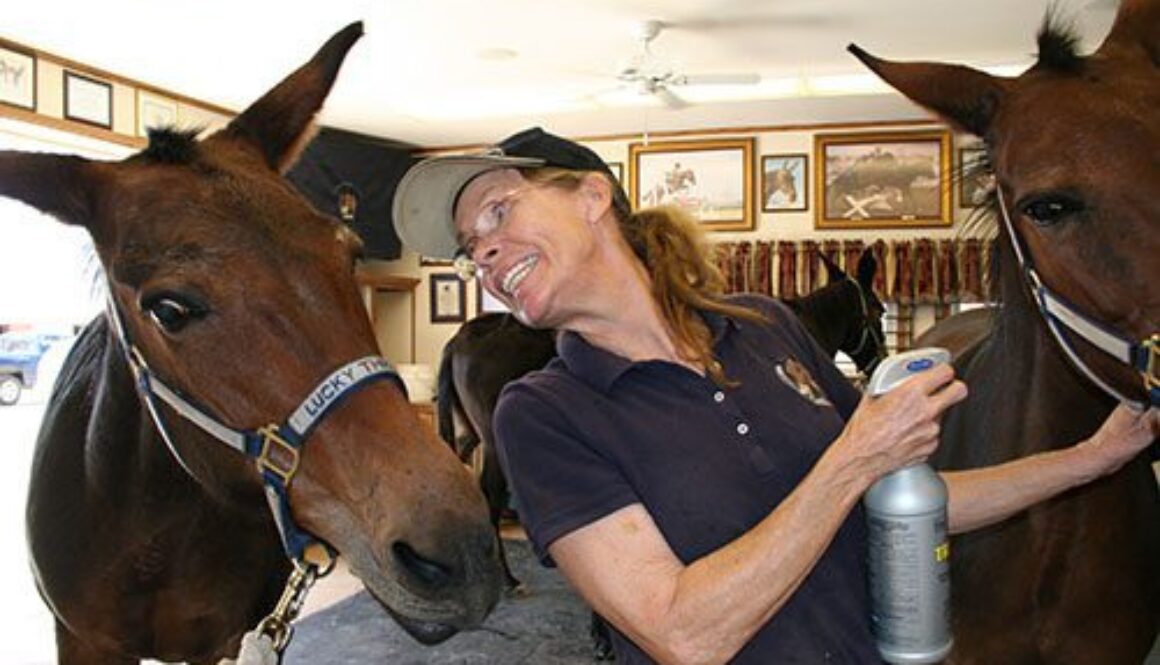
LTR Training Tip #3: Work Stations
Meredith gets a lot of letters and emails from people with training questions about their equines. Here, she discusses how to set up a work station for tack and grooming your equine.

MULE TALK! PODCAST: Keys to Successful Training Part 1
Keys to Successful Training Part 1 –
- The Work Station
- Tack and Equipment
- In the Round Pen
- Be aware of how your own body language and verbal commands elicit certain behaviors in your animal.
- The Hard Tie as a restraint and how to use it.
- In the Arena
- Open Areas
Learn more on Mule Talk podcast.

MULE TALK! PODCAST: Fine-tuning the Rider/Fine-tuning the Aids
Fine-tuning the Rider/Fine-tuning the Aids —
- The benefits of using positive reinforcement early on in your mule’s training.
- Apply corrective measures appropriately when working with your young mule.
- Each mule learns in their own way and at their own pace.
- Using your seatbones to fine-tune your aids.
- Use half-halts when making a transition will alert your mule a change is going to occur.
- Using circles to benefit your training.
- Working at a pace so as not to confuse or create anxiety in your mule.
- Establishing fine-tuning will create harmony and balance in your work.
- This and more details in this episode!
Learn more on Mule Talk podcast.
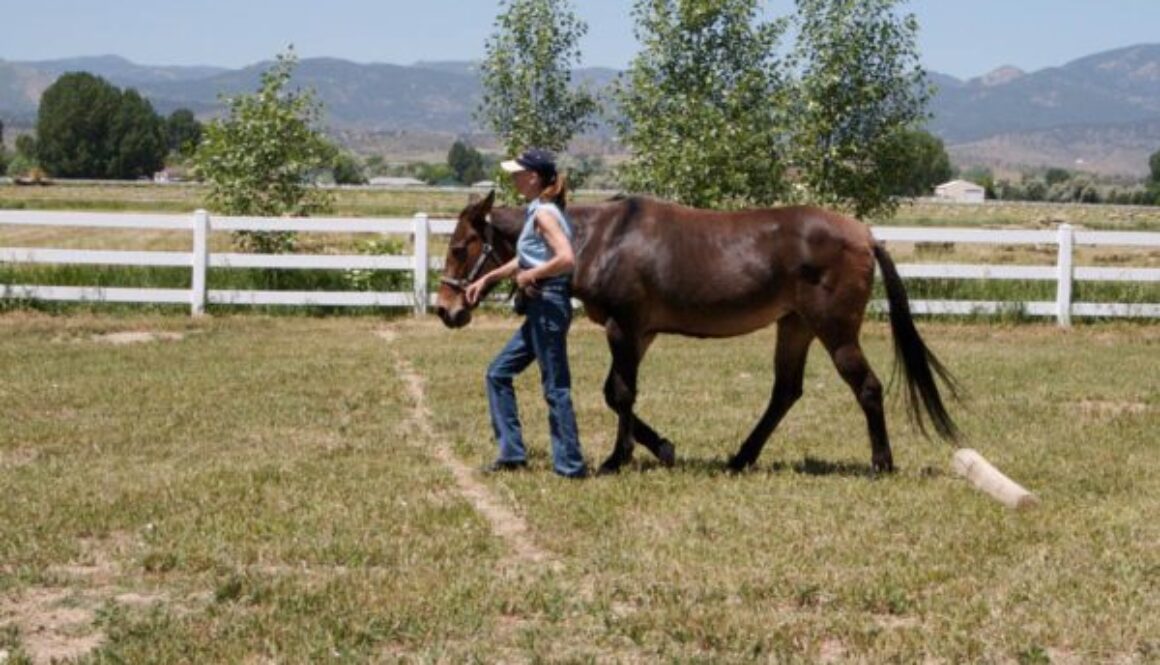
LTR Training Tip #2: The Danger of Halters
Meredith gets a lot of letters and emails from people with training questions about their equines. Here, she talks about the dangers of leaving the halter on your equine, and some alternatives for catching them.
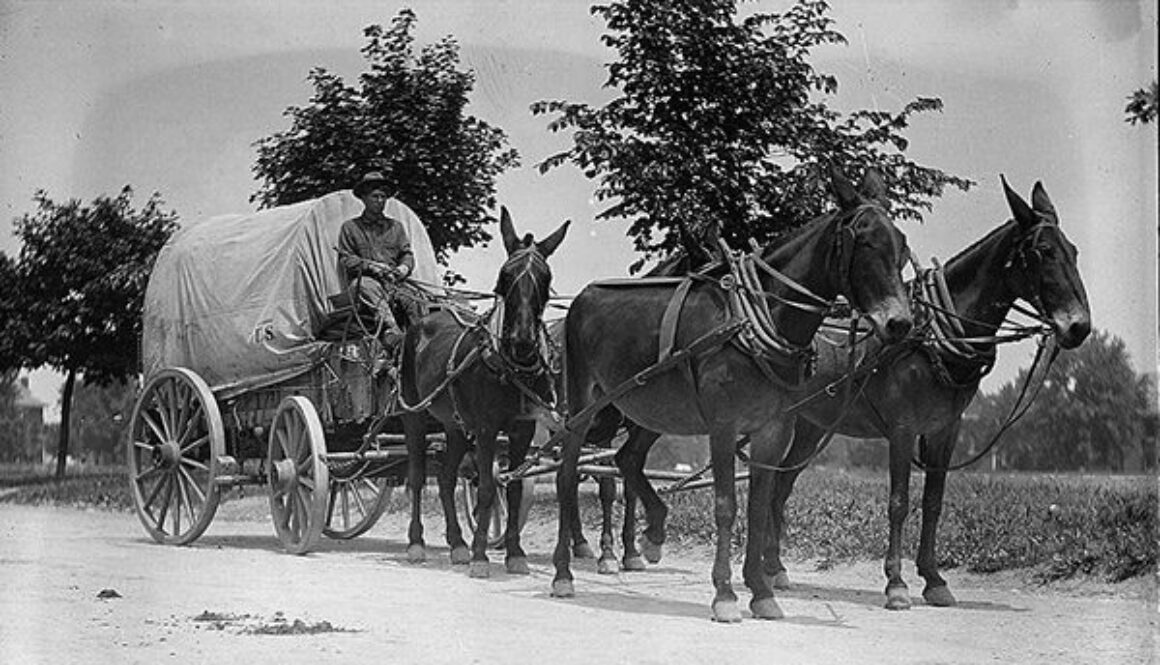
MULE TALK! PODCAST: Making History With Mules Part 3
Making History With Mules –
- Mules before the industrial age were vital to the United States and utilized for heavy work.
- Mules during the Westward Expansion days, transported families and their possessions through the Western Plains.
- The U.S. Cavalry and their role in using mules.
- Harvey Riley, author of The Mule, published in 1867 – an excellent source of the mule and its history in the U.S. Army.
- Soldier, Jimmy Wright was saved by his mule during a horrific battle; his mule dragged him to safety.
Learn more on Mule Talk podcast.
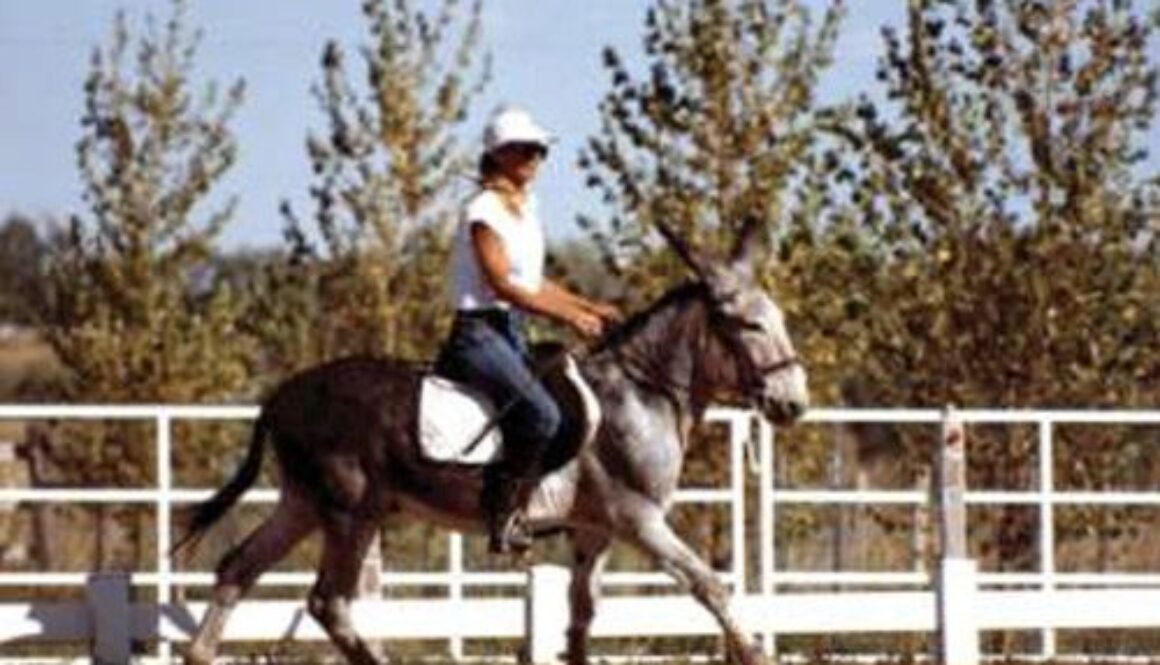
MULE CROSSING: Fine-Tuning the Rider
TRAINING MULES & DONKEYS
CHAPTER 27
Fine-Tuning the Rider
By Meredith Hodges
No training series would be complete without examining the principles and philosophy behind the training program. My philosophy is based on the principle that I am not, in fact, “training” donkeys and mules. Rather, I am cultivating relationships with them by assigning meaning to my body language that they can understand while I learn what they are trying to indicate to me with their body language.
In the same way that my own level of understanding changes and grows over time, I believe that my animals’ understanding grows, too. In the beginning, the emotional needs of a young mule are different from those of an older animal. The young mule needs to overcome many instincts that would protect him in the wild, but are inappropriate in a domestic situation. In a domestic situation, the focus must be on developing friendship and confidence in the young mule, while establishing my own  dominance in a non-threatening manner. This is accomplished through the use of a great deal of positive reinforcement early on, including gentle touches, a reassuring voice and lots of rewards for good behavior. Expressions of disapproval should be kept to a minimum and the negative reinforcement for bad behavior should be clear, concise and limited.
dominance in a non-threatening manner. This is accomplished through the use of a great deal of positive reinforcement early on, including gentle touches, a reassuring voice and lots of rewards for good behavior. Expressions of disapproval should be kept to a minimum and the negative reinforcement for bad behavior should be clear, concise and limited.
As your young mule grows and matures, he will realize that you do not wish to harm him. Next, he will develop a rather pushy attitude in an attempt to assert his own dominance (much like teenagers do with their parents), because he is now confident that this behavior is acceptable. When this occurs, reevaluate your reward system and save excessive praise for the new exercises as he learns them. Allow the learned behavior to be treated as the norm, and praise it more passively, yet still in an appreciative manner. This is the concept, from an emotional standpoint, of the delicate balance of give and take in a relationship. As in any good relationship, you must remain polite and considerate of your mule or donkey. After all, “You can catch more flies with sugar than you can with vinegar.”
Many details of both mule and trainer must also be considered from a physical standpoint. In the beginning, unless you are a professional trainer with years of proper schooling, you are not likely to be the most balanced and coordinated of riders, and you may lack absolute control over your body language. By the same token, the untrained mule will be lacking in the muscular coordination and strength it takes to respond to your request to perform certain movements. For these reasons, you must modify your approaches to fit each new situation, and then modify again to perfect it, keeping in mind that your main goal is to establish a good relationship with your mule and not just to train him. It is up to you, the trainer, to decide the cause of any resistance from your mule, and to modify techniques that will temper that resistance, whether it is mental or physical.
Here is an example: I had a three-year-old mule that was learning to lunge without the benefit of the round pen. The problem was that he refused to go around me more than a couple of times without running off. I first needed to assess the situation by brainstorming all the probable reasons why he might keep doing such an annoying thing. Is he frightened? Is he bored? Is he  mischievous? Has he been calm and accepting of most things until now? And, most important, is my own body language causing this to occur? Once I was willing to spend more time with regard to balance on the lead rope exercises and proceeded to the round pen to learn to balance on the circle, I soon discovered that developing good balance and posture was critical to a mule’s training. The reason my mule was pulling on the lunge line so hard was because he just could not balance his own body on a circle. Once I reviewed the leading exercises with him—keeping balance, posture and coordination in mind—and then went to the round pen to learn to balance on the circle, I noticed there was a lot less resistance to everything he was doing. I introduced the lunge line in the round pen and taught him how to circle with slack in the line. After that, lunging in the open arena on the lunge line was much easier and he did maintain the slack in the line while circling me.
mischievous? Has he been calm and accepting of most things until now? And, most important, is my own body language causing this to occur? Once I was willing to spend more time with regard to balance on the lead rope exercises and proceeded to the round pen to learn to balance on the circle, I soon discovered that developing good balance and posture was critical to a mule’s training. The reason my mule was pulling on the lunge line so hard was because he just could not balance his own body on a circle. Once I reviewed the leading exercises with him—keeping balance, posture and coordination in mind—and then went to the round pen to learn to balance on the circle, I noticed there was a lot less resistance to everything he was doing. I introduced the lunge line in the round pen and taught him how to circle with slack in the line. After that, lunging in the open arena on the lunge line was much easier and he did maintain the slack in the line while circling me.
Like humans, all animals are unique, and, like humans, each learns in his own way. Learn to be fair and flexible in your approach to problems. It is best to have a definite program that evolves in a logical and sequential manner that addresses your mule’s needs physically, mentally and emotionally. Be firm in your own convictions, but be sensitive to situations that can change, and be willing to make those changes as the occasion arises. This is what learning is all about for both you and your mule.
Just as mental changes occur, so do physical changes. As your mule’s muscles develop and coordination improves, you will need to do less and less to cause certain movements. For example, in the case of the leg-yield, you may have to turn your mule’s head a little too far in the opposite direction to get him to step sideways and forward. You will need to guide him more strongly with the reins and kick harder. As he becomes stronger and more coordinated, and begins to understand your aids, you can then start to straighten his body more toward the correct bend and stay quieter with your aids. Granted, you began by doing things the “wrong” way by over-bending your mule and by over-using your aids, yet you put your mule “on the road” to the right way. You assimilated an action in response to your leg that can now be perfected over time. In essence, you have simply told your mule, “First you must learn to move away from my leg, and then you can learn to do it gracefully.”
The same concept works in the case of the trainer or the rider. Sometimes you must do things that are not quite right in the  beginning to get your own body to assimilate correctness. In the beginning, a rider cannot “feel” the hind legs coming under his seat, so he needs to learn by watching the front legs moving forward along with his hands. With practice, the rider will develop the “feel” and will no longer need to watch the front legs moving forward. Remember, we all perceive things a little differently, and our perception depends on how we are introduced to something and on whether or not we can understand or perform a task.
beginning to get your own body to assimilate correctness. In the beginning, a rider cannot “feel” the hind legs coming under his seat, so he needs to learn by watching the front legs moving forward along with his hands. With practice, the rider will develop the “feel” and will no longer need to watch the front legs moving forward. Remember, we all perceive things a little differently, and our perception depends on how we are introduced to something and on whether or not we can understand or perform a task.
It is nearly impossible for the inexperienced horseman to perceive and control unused seat bones as a viable means of controlling the mule. Reins and legs are much more prevalent. In order to help such a rider perceive their seat bones more clearly, it sometimes helps to start by involving the whole lower body. Earlier in this book, I suggested that, to begin facilitating this action, you pedal forward in conjunction with the front legs. Connecting this action with the front legs of the mule allows you to “see” something concrete with which you can coordinate, plus the pedaling encourages necessary independent movement in the seat bones from side to side and forward. When you begin to “feel” this sensation, you can begin to understand that when the foreleg comes back, the corresponding hind leg is coming forward under your seat bone. When you understand this, both mentally and physically, you can begin to pedal backward, which will cause you to be in even closer in synchronization with your mule’s body. As your leg muscles become more stable, actual movement in your own body becomes less, more emphasis is directed toward your center of gravity and more responsibility is placed on your seat bones. Using this approach, your muscles are put into active use and coordinated with your mule’s body through gymnastic exercises, which will eventually lead to correct position and effective cueing.
 Achieving balance and harmony with your mule requires more than just balancing and conditioning your mule’s body. As you begin to finish-train your mule, you should shift your awareness more toward your own body. Your mule should already be moving forward fairly steadily and in a longer frame, and basically be obedient to your aids. The objective of finish-training is to build the muscles in your own body, which will cause your aids to become more effective and clearly defined. This involves shedding old habits and building new ones, which takes a lot of time and should not be approached with any impatience. Remember: there are no shortcuts. In order to stabilize your hands and upper body, you need to establish a firm base in your seat and legs. Ideally, you should be able to drop a plumb line from your ear to your shoulder, down through your hips, through your heels and to the ground. To maintain this plumb line, work to make your joints and muscles in your body more supple and flexible by using them correctly. Always look where you are going to keep your head in line with the rest of your body.
Achieving balance and harmony with your mule requires more than just balancing and conditioning your mule’s body. As you begin to finish-train your mule, you should shift your awareness more toward your own body. Your mule should already be moving forward fairly steadily and in a longer frame, and basically be obedient to your aids. The objective of finish-training is to build the muscles in your own body, which will cause your aids to become more effective and clearly defined. This involves shedding old habits and building new ones, which takes a lot of time and should not be approached with any impatience. Remember: there are no shortcuts. In order to stabilize your hands and upper body, you need to establish a firm base in your seat and legs. Ideally, you should be able to drop a plumb line from your ear to your shoulder, down through your hips, through your heels and to the ground. To maintain this plumb line, work to make your joints and muscles in your body more supple and flexible by using them correctly. Always look where you are going to keep your head in line with the rest of your body.
As you ride your mule through the walking exercise, try to stay soft, relaxed and forward in your inner thighs and seat bones. Get the sensation that your legs are cut off at the knees, and let your seat bones walk along with your mule, lightly and in rhythm with him behind his front legs. If he slows down, just bend your knees and bump him alternately with your legs below the knees, while you keep your seat and upper legs stable and moving forward. When collecting the walk on the short side, just bend both knees at the same time, bumping your mule simultaneously on both sides, while you squeeze the reins at the same time. Your legs should always have contact with your mule’s body in a light “hugging” fashion and real pressure should only come during the cues.
In order to help you stay over the middle of your mule’s back on the large circle, keep your eyes up and looking straight ahead. Shift your weight slightly to the outside stirrup, and feel it pull your inside leg snugly against your mule. Be sure that your outside leg stays in close to your mule’s barrel as you do this. On straight lines, keep your legs even, but on the arc, and look a little to the outside of the circle. This will bring your inside seat bone slightly forward, allowing your legs to be in the correct position for the circle. Note: This technique is particularly helpful during canter transitions.
Most people feel that they do not balance on the reins as much as they actually do. If you balance on the reins at all, your mule will be unable to achieve proper hindquarter engagement and ultimate balance. To help shift the weight from the hands and  upper body to the seat and legs, you can do a simple exercise: Put your mule on the rail at an active working walk. On the long side, drop your reins on his neck and feel your lower body connect with his body as you move along. You will need to tip your pelvis forward and stretch your abdominal muscles with each step in order to maintain your shoulder to hip plumb line. If your lower leg remains in the correct position, your thigh muscles will be stretched on the front of your leg from your hip to your knee. There is also a slight side-to-side motion as your mule moves forward that will cause your seat bones to move independently and alternately forward. There is no doubt that you can probably do this fairly easily right from the start, but to maintain this rhythm and body position without thinking about it takes time and repetition.
upper body to the seat and legs, you can do a simple exercise: Put your mule on the rail at an active working walk. On the long side, drop your reins on his neck and feel your lower body connect with his body as you move along. You will need to tip your pelvis forward and stretch your abdominal muscles with each step in order to maintain your shoulder to hip plumb line. If your lower leg remains in the correct position, your thigh muscles will be stretched on the front of your leg from your hip to your knee. There is also a slight side-to-side motion as your mule moves forward that will cause your seat bones to move independently and alternately forward. There is no doubt that you can probably do this fairly easily right from the start, but to maintain this rhythm and body position without thinking about it takes time and repetition.
When you are fairly comfortable at the walk, you can add some variation at the trot. Begin at the posting trot on the rail. When your mule is going around in a fairly steady fashion, drop your reins on his neck and continue to post. As you post down the long side, keep your upper body erect and your pelvis rocking forward from your knee. Your knee should be bent so that your legs are positioned on the barrel of your mule. Raise your arms out in front of you, parallel to your shoulders. If your mule drifts away from the rail, you need to post with a little more weight in your outside stirrup. As you go around corners, be sure to turn your eyes a little to the outside of the circle to help maintain your position. As you approach the short side of the arena, bring your arms back, straight out from your shoulders, and keep your upper body erect. As you go through the corners, just rotate your arms and upper body slightly toward the outside of your circle. When you come to the next long side, once again bring your arms in front of and parallel to your shoulders, and repeat the exercise.
Notice the different pressure on your seat bones as you change your arm position. When your arms are forward it will somewhat lighten your seat, while having your arms to the side will tend to exert a little more pressure. Consequently, you can send your mule more forward with your seat as you go down the long sides. On the short sides, you can shorten that stride with a little added pressure from the seat bones. When you wish to halt, put your arms behind you at the small of your back to support an erect upper body, and let your weight drop down through your seat bones and legs to total relaxation and an entire halting of movement. Remember to use your verbal commands—especially in the beginning—to clarify your aids to your mule. If your mule doesn’t stop, just reach down and give a gentle tug on the reins until he stops. Before long, he will begin to make the connection between your seat and your command to “Whoa,” and your seat will take precedence over your reins.
 When you and your mule have become adept at the walk and the trot, add the canter. At the canter, however, keep your arms out to the side and rotate them in small backward circles in rhythm with the canter. Be sure to sit back and allow only your pelvis, your seat and your thighs to stretch forward with the canter stride. Keep your upper body erect and your lower leg stable from the knee down. Once your mule has learned to differentiate seat and leg aids in each gait and through the transitions on the large circle, you can begin to work on directional changes through the cones.
When you and your mule have become adept at the walk and the trot, add the canter. At the canter, however, keep your arms out to the side and rotate them in small backward circles in rhythm with the canter. Be sure to sit back and allow only your pelvis, your seat and your thighs to stretch forward with the canter stride. Keep your upper body erect and your lower leg stable from the knee down. Once your mule has learned to differentiate seat and leg aids in each gait and through the transitions on the large circle, you can begin to work on directional changes through the cones.
As you practice these exercises, you will soon discover how even the slightest shift of balance can affect your mule’s performance. By riding without your reins and making the necessary adjustments in your body, you will begin to condition your own muscles to work in harmony with those of your mule. As your muscles get stronger and more responsive, you will cultivate more harmony and balance with your mule. As you learn to ride more “by the seat of your pants,” you will encounter less resistance in your mule, because most resistance is initiated by “bad hands” due to an unstable seat. As you learn to vary the pressure in your seat accordingly, you will also encounter less resistance in your mule through his back. Having a secure seat will help to stabilize your hands and make rein cues much more clear to your mule. The stability in your lower leg will also give him a clearer path to follow between your aids.
To learn more about Meredith Hodges and her comprehensive all-breed equine training program, visit LuckyThreeRanch.com, MEREDITH HODGES PUBLIC FIGURE Facebook page, or call 1-800-816-7566. Check out her children’s website at JasperTheMule.com. Also, find Meredith on Pinterest, Instagram, MeWe, YouTube and Twitter.
Covered in TRAINING MULES & DONKEY: A LOGICAL APPROACH TO TRAINING, TRAINING WITHOUT RESISTANCE, EQUUS REVISITED and A GUIDE TO RAISING & SHOWING MULES at www.luckythreeranchstore.com.
© 2024 Lucky Three Ranch, Inc. All rights reserved.

MULE TALK! PODCAST: Making History With Mules Parts 1 & 2
Making History With Mules –
- Mules and donkeys are mentioned in the Bible.
- The highest intelligence residing in animals is that of the mule.
- Learn how mules played a significant part in Greek and Roman transportation.
- HAI-BAR, a volunteer organization established to protect animals that had thrived in the Holy Land during the Old Testament years – but are now dangerously close to extinction.
- Unique personality traits of the mule come from the ass.
- George Washington – the first organized mule breeder in America.
- Hear how the Erie Canal was built by mules.
- Hear about the borax mule team from Death Valley hauling over the mountains to the Mojave Desert and more!
Learn more on Mule Talk podcast.
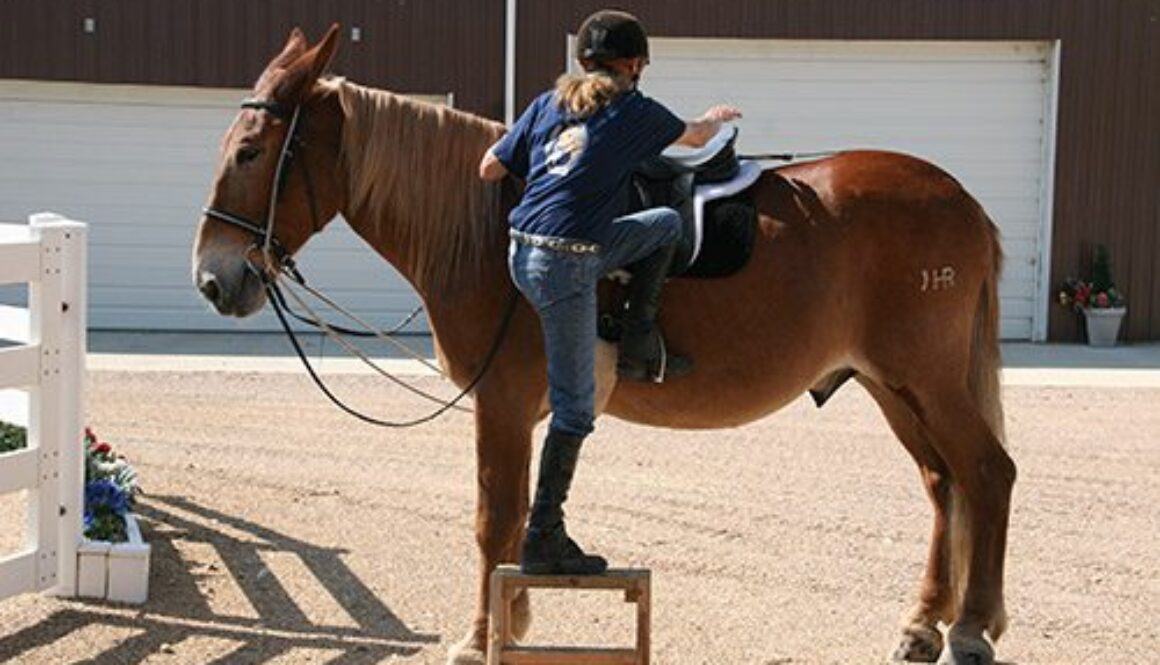
MULE TALK! PODCAST: Standing Still While Mounting
Standing Still While Mounting –
- It starts with good nutrition and being fed on schedule to reduce anxiety.
- Ground training is essential using a logical approach.
- Begin mounting in the round pen first – using a mounting block.
- Desensitize your mule with gentle strokes to the body to learn his sensitive areas.
- Start with a mounting block to eliminate pulling on the saddle.
- Have an assistant work with you for safety reasons.
- Sit quietly for a minute before walking on after mounting.
- Train your mule to understand the command “WHOA.”
- Train your mule to understand the command “STAND” when you are ready to mount him.
- Use the reward system to let him know he is doing good.
- Balance your weight when stepping up into the saddle and stepping down.
- English riders – remove both feet from stirrups when dismounting.
- Western riders position your foot in the left stirrup to eliminate getting hung up.
- Ride in a saddle that is comfortable for your mule and a proper fit for you the rider. This will eliminate potential hazards.
Learn more on Mule Talk podcast.

MULE TALK! PODCAST: Do Mules Need to Be Shod?
- Take into consideration where you will ride your mule.
- Terrain – rocky – mud – sand – grass – mountain trails – prairie
- Mules inherit their hooves through their genes.
- Climate and weather greatly affect the condition of your mule’s feet.
- Hoof products – are often overused.
- Stress rings and what they mean.
- Your mule’s diet is important to producing healthy hooves.
Learn more on Mule Talk podcast.
